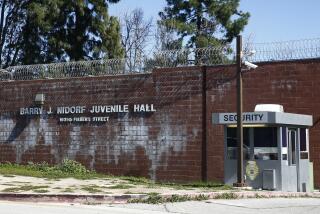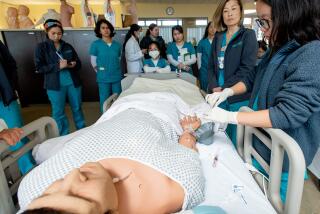Four prisons in California to get community college programs

The White House plan announced last week to award federal education funding to prison inmates spotlighted a population that is often an afterthought in the national discussion on college access.
More than 1.5 million people are behind bars in state and federal prisons, according to the U.S. Department of Education, and when those on parole or probation are included, the number under some sort of correctional supervision swells to nearly 7 million.
More than 700,000 inmates are released each year, a significant but marginalized population frequently unprepared for life on the outside, with few skills and often without a high school diploma. College-level instruction on the inside is mostly a patchwork of correspondence courses and privately-funded in-house programs staffed by volunteers.
In many states, including California, investment in rehabilitation and education services has for the most part fallen by the wayside.
But the tide may be turning in favor of efforts to address the paucity of post-secondary options, driven by a growing body of research that suggests educated inmates are more likely to stay out of prison and become productive members of the community.
Besides the federal Pell grant project, several California community colleges will launch programs at four state prisons this fall, following recent legislation that increases funding for inmate education.
A 2013 study by the Rand Corp., funded by the U.S. Department of Justice, found that inmates who participated in educational programs were 43% less likely to return to prison within three years than those who didn’t participate. The study found that every dollar invested in prison education programs saved nearly $5 on later incarceration costs.
“The fact that incarceration has become such a huge crisis in this country, with an exploding population under some form of correctional control ... has renewed attention to the fact that the majority are going to be released back to society at some point,” said Julie Ajinkya, director of applied research for the Institute for Higher Education Policy in Washington. “We have decades of research telling us that post-secondary education in correctional facilities are the most effective education programs at reducing recidivism.”
In 1994, Congress withdrew Pell grant eligibility from those in state and federal prisons. Hundreds of education programs were cut because of a lack of funds. The Obama Administration’s Second Chance Pell Pilot Program would restore eligibility to program participants and study the impact.
Pell grants are designed for low-income students; prisoners would need to meet income requirements.
Participating colleges and other educational institutions would be chosen based on their success in graduating students and other criteria.
President Obama tweeted (@POTUS): “Launching a pilot program to help students in prison pay for college, because everyone willing to work for it deserves a second chance.”
The plan drew criticism from some Republicans, though, including the Senate education committee chairman, Sen. Lamar Alexander (R-Tenn). In a statement, Alexander said the program may be worthwhile, but that he believes the White House needs approval from Congress.
“The Obama Administration should focus on the existing prisoner job training and re-entry programs through the Departments of Justice and Labor for which Congress provided nearly $300 million last year,” he said. Changes to the Pell grants can be made when the Higher Education Act is reauthorized, he said.
But many education and civil rights leaders said that change is long overdue. A number of members of Congress, including Rep. Barbara Lee (D-Oakland), are pushing legislation to fully restore Pell grant eligibility for inmates in federal and state prisons.
California’s state prison facilities house more than 111,400 inmates, according to the Department of Corrections and Rehabilitation. Nearly 7,000 of them are enrolled in mostly distance-learning courses. State officials said they welcomed the increased availability of Pell grants.
More than 6,000 inmates enrolled in college programs last year, mostly to get two-year associate’s degrees; only 9 were able to afford undergraduate classes to receive a bachelor’s degree, said Brant Choate, state superintendent of correctional education.
The new federal program “will provide the much needed funding to ensure those who are interested in turning their lives around are provided that opportunity,” he said.
The state also has been moving to boost education access for inmates, after a 2014 law that allowed community colleges to receive the same level of state funding for educating students behind prison walls as they do for students on college campuses.
The legislation called for collaboration between prison and community college officials to provide college instruction, resulting in a $2 million, 18-month pilot program launching this fall. The schools include Lassen College in Susanville paired with High Desert State Prison; Folsom Lake College paired with Folsom Women’s Facility; Antelope Valley College in Lancaster with California State Prison, Los Angeles County; and Chaffey College in Rancho Cucamonga with the California Institution for Women.
The program will offer two to three courses each semester with up to 25 students in each class. Curriculum will focus on business and entrepreneurship, with the chance to earn an associate’s degree in liberal arts.
“Part of the proposal was to look for innovative programs that are not only face-to-face but offer a full student experience of orientation, advising, counseling,” said BJ Snowden, director of inmate education in the community college chancellor’s office. “We want this to be a sustainable and replicable model with real goals.”
One of the state’s most successful prison education programs, the Prison University Project, will provide training for community college faculty.
The privately-funded project operates at San Quentin and was founded after inmates lost Pell eligibility. Instructors come from the faculty ranks at UC Berkeley, Stanford and San Francisco State University, said executive director Jody Lewen.
Obama’s Pell grant initiative could greatly aid programs like hers, Lewen said, providing it is focused on offering a quality education.
“It could be fantastic, but if we allow institutions to come in and do it as cheap as possible with little investment, it will be garbage,” Lewen said. “It will be one of those things in the prison system that’s called better than nothing.”
Twitter: @carlariveralat
----------
FOR THE RECORD
Aug. 5, 2015, 9:15 a.m.: The headline on an earlier online version of this article said “California colleges will join Pell grant project, launch education programs at 4 prisons.” The programs being launched by community colleges at the prisons are separate from the federal Pell grant program for educating inmates.
------------
More to Read
Sign up for Essential California
The most important California stories and recommendations in your inbox every morning.
You may occasionally receive promotional content from the Los Angeles Times.











